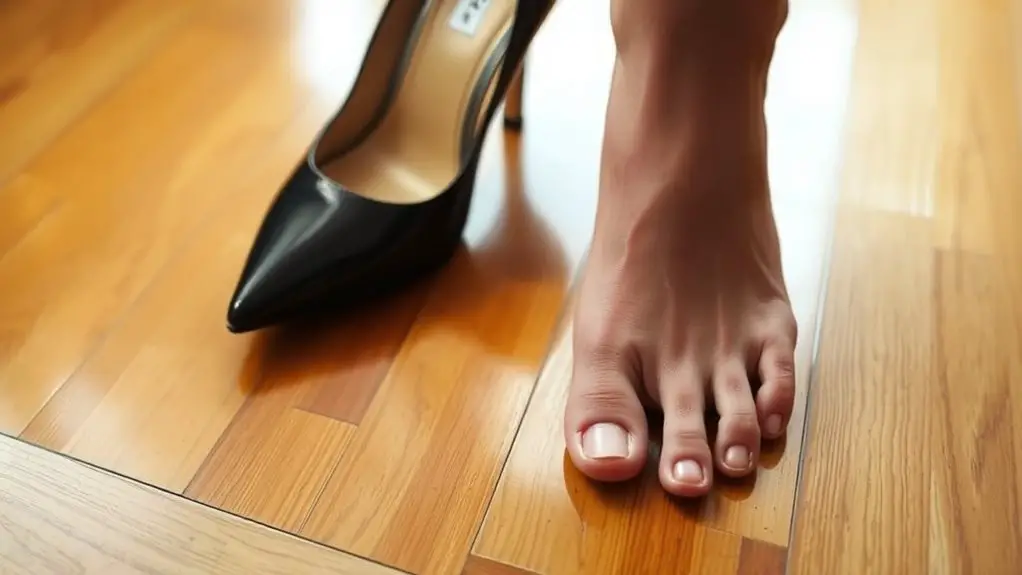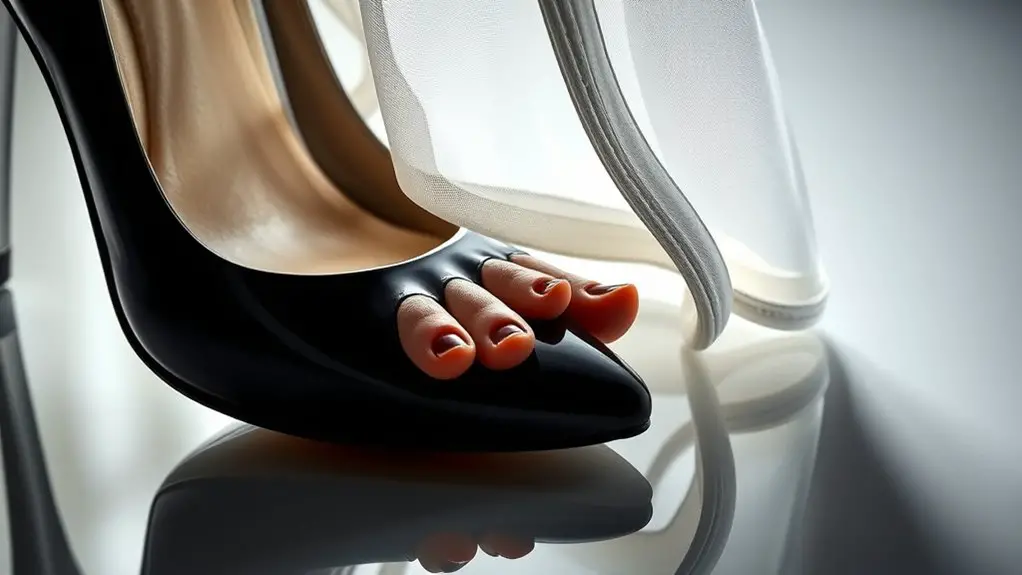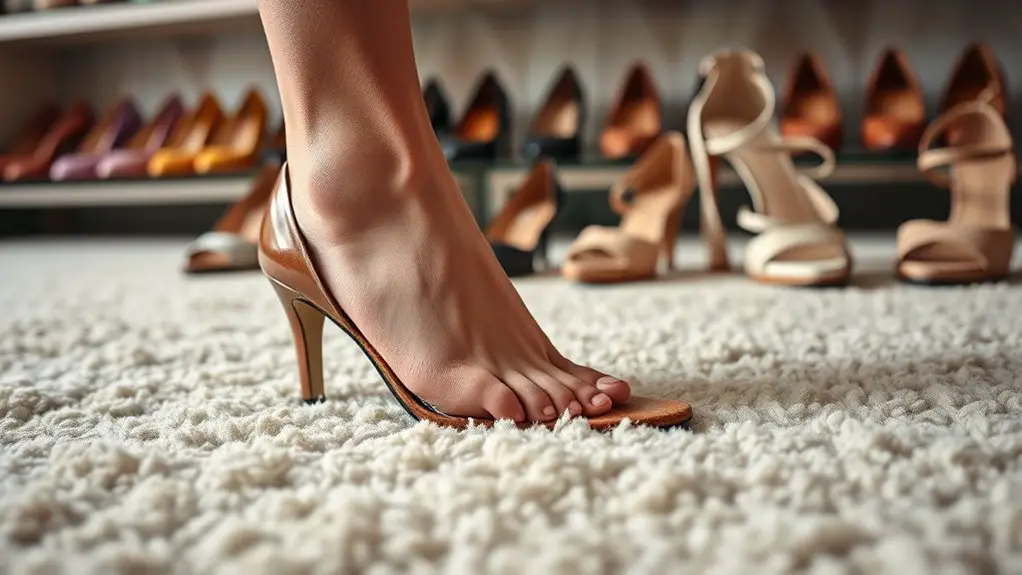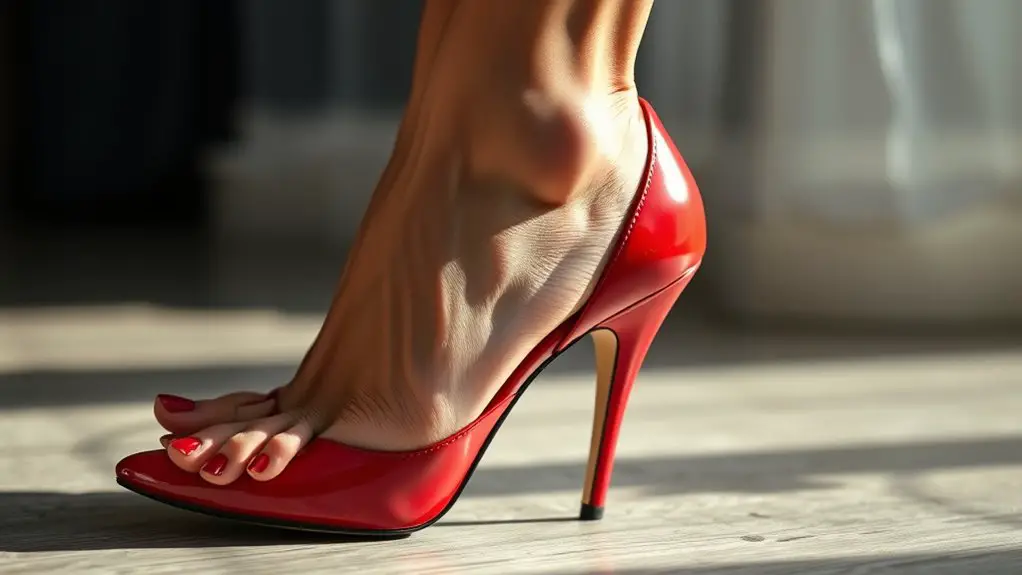Wearing high heels can indeed increase your risk of developing hammer toes. The unnatural positioning and pressure from high heels force your toes into an abnormal alignment, which can lead to muscle imbalances and joint strain. Tight toe boxes restrict movement, while excessive pressure can result in pain and deformity. Choosing the right footwear and taking preventative measures is vital for maintaining foot health. There’s more to reflect upon when it comes to your footwear choices and foot care options.
Understanding Hammer Toes: Causes and Symptoms

Although many people may not realize it, hammer toes can greatly impact foot function and comfort. Hammer toes occur when the toe bends at the middle joint, resulting in a claw-like appearance. The primary causes include muscle imbalances, arthritis, and wearing ill-fitting footwear, particularly high heels. These factors can lead to an abnormal position of the toe, increasing pressure on the joints.
You might notice several symptoms if you’re experiencing hammer toes. Common signs include pain or discomfort in the affected toe, swelling, and difficulty walking. You may also observe calluses or corns developing on the top or tip of the toe due to friction with footwear. Over time, if left untreated, hammer toes can lead to more severe complications, including joint damage. Understanding these hammer toes causes and symptoms is essential for early intervention and effective management.
The Anatomy of High Heels: How They Affect Foot Structure
High heels, often seen as a fashion staple, considerably alter the natural structure of the foot. The elevated heel design shifts your body’s weight forward, placing excessive pressure on the forefoot. This alteration can lead to a misalignment of the foot structure, affecting the distribution of weight across the toes and arches.
Additionally, the narrow toe box common in many high heels constricts the toes, limiting their natural movement and flexibility. Over time, this can lead to muscle imbalances and joint stress, further compromising foot structure. The rigid materials often used in heel design can also restrict the foot’s natural biomechanics, inhibiting the shock absorption capabilities essential for daily activities.
As a result, wearing high heels may not only impact comfort but can also have long-term implications for your foot health, warranting careful consideration of their regular use.
The Connection Between High Heels and Hammer Toes

The shift in weight distribution caused by high heels can lead to various foot conditions, including hammer toes. When you wear high heels, especially those with significant heel height, your foot alignment changes dramatically. This can result in the toes being forced into an unnatural position, increasing the risk of developing hammer toes.
Wearing high heels alters foot alignment, forcing toes into unnatural positions and increasing the risk of hammer toes.
- High heels place excessive pressure on the toes.
- Altered foot alignment can strain tendons and ligaments.
- Prolonged wear of high heels exacerbates discomfort.
- The shape of the shoe often restricts toe movement.
- Muscle imbalances may develop over time.
These factors contribute to the formation of hammer toes, where the toes bend at the joints, leading to pain and difficulty in walking. To mitigate these risks, consider the heel height and choose footwear that supports proper foot alignment.
Risk Factors for Developing Hammer Toes
While certain lifestyle choices and genetic predispositions can increase your likelihood of developing hammer toes, several key risk factors should be considered. To begin with, if you have a family history of foot deformities, your genetic predisposition considerably raises your risk. This hereditary factor can manifest in the structure of your feet, making them more susceptible to conditions like hammer toes.
Additionally, specific lifestyle choices play an essential role. Regularly wearing tight or high-heeled shoes can exacerbate toe deformities, forcing your toes into unnatural positions. Furthermore, engaging in activities that put excessive pressure on your feet, such as certain sports or prolonged standing, can contribute to developing hammer toes over time.
Lastly, age is a factor; as you get older, the tendons and ligaments in your feet may weaken, increasing the likelihood of deformities. Recognizing these risk factors can help you make informed decisions about your foot health.
Preventative Measures: Choosing the Right Footwear

Choosing the right footwear is essential for preventing hammer toes, especially if you’re susceptible due to genetic or lifestyle factors. The shoes you wear can greatly affect the alignment of your toes. Here are some guidelines to take into account:
- Opt for flexible footwear materials that allow your feet to move naturally.
- Choose shoes with a wide toe box to reduce pressure on your toes.
- Select a low heel height, ideally under two inches, to minimize strain on your feet.
- Look for cushioned insoles that provide support and comfort throughout the day.
- Avoid pointy or narrow shoes that force your toes into unnatural positions.
Remedies for Hammer Toes: Treatment Options
If you’re dealing with hammer toes, there are several effective treatment options to evaluate. Stretching exercises can provide relief and improve flexibility, while proper footwear is essential for preventing further complications. Additionally, orthotic inserts can offer support and reduce discomfort during daily activities.
Stretching Exercises for Relief
Although hammer toes can cause significant discomfort, incorporating stretching exercises into your routine can provide relief and improve foot function. These stretching techniques enhance foot flexibility, reducing pain and preventing further deformity. Here are some effective exercises you can try:
- Towel curls: Use your toes to scrunch a towel towards you.
- Toe stretches: Gently pull your toes back with your hands.
- Calf stretches: Stand facing a wall, lean forward to stretch your calves.
- Toe raises: Lift your toes while keeping your heels on the ground.
- Foot roll: Roll your foot over a tennis ball to release tension.
Proper Footwear Recommendations
Selecting the right footwear is essential for managing hammer toes and preventing further discomfort. Choose comfortable sandals that provide adequate room for your toes to move freely. Look for styles with adjustable straps to accommodate swelling and provide a secure fit. Supportive sneakers are another excellent option, as they offer cushioning and stability. Opt for shoes with a wide toe box, guaranteeing your toes aren’t cramped or forced into unnatural positions. Avoid high heels and pointed-toe shoes, as these can exacerbate your condition. Instead, prioritize footwear that promotes proper alignment and distributes pressure evenly across your feet. Regularly assess your shoe choices to confirm they continue to meet your needs as your condition changes.
Orthotic Inserts Benefits
While choosing the right footwear is important for managing hammer toes, orthotic inserts can provide additional support and relief. These inserts help alleviate discomfort and promote proper foot alignment, offering several orthotic benefits, including:
- Enhanced arch support for better weight distribution
- Improved heel support to reduce strain on the toes
- Cushioning that absorbs shock during walking
- Correction of foot positioning to alleviate pressure
- Increased stability, reducing the risk of further injury
Exercises to Strengthen Foot Muscles and Improve Flexibility
Strengthening foot muscles and improving flexibility are essential for maintaining foot health, especially for those who wear heels regularly. Incorporating specific foot strengthening and flexibility exercises into your routine can help mitigate the risks associated with wearing high heels.
Begin with toe curls: while seated, place a towel on the floor and use your toes to scrunch it towards you. Next, perform calf stretches by standing on a step and lowering your heels, holding for 15-30 seconds. Another effective exercise is the ankle circle; lift one foot off the ground and rotate your ankle in both directions.
Finally, try marble pickups: scatter marbles on the floor and pick them up using your toes. These exercises not only strengthen the muscles in your feet but also enhance flexibility, reducing the likelihood of developing conditions like hammer toes. Regular practice will contribute to healthier, more resilient feet.
Alternatives to High Heels: Stylish Yet Comfortable Options
If you’re looking for stylish yet comfortable alternatives to high heels, several footwear options can provide both elegance and support. You don’t have to sacrifice style for comfort; options exist that can keep your feet healthy and fashionable. Consider the following alternatives:
- Comfortable flats: These come in various styles, from ballet to loafers, offering support without compromising on aesthetics.
- Stylish sneakers: Great for casual outings, they provide cushioning and arch support while remaining trendy.
- Wedges: A moderate heel provides a lift without the discomfort of stilettos, maintaining stability.
- Ankle boots: They offer support and can be dressed up or down, suitable for various occasions.
- Espadrilles: Perfect for warmer months, they combine style and comfort with breathable materials.
Exploring these options can enhance your wardrobe while prioritizing foot health.
Frequently Asked Questions
Can Hammer Toes Be Hereditary or Genetic?
Yes, hammer toes can be hereditary. If there’s a family history of foot deformities, genetic factors may play a significant role in your likelihood of developing this condition, emphasizing the importance of monitoring your foot health.
Are Certain Foot Shapes More Prone to Hammer Toes?
Around 25% of adults have foot shapes that increase hammer toe risk. If your foot anatomy features a high arch or long toes, proper shoe fit becomes essential in preventing discomfort and deformities like hammer toes.
How Do I Know if I Have Hammer Toes?
To determine if you have hammer toes, examine your feet for symptoms like toe deformity or discomfort. A thorough toe examination can reveal misalignment, while observing any pain or difficulty in movement aids in diagnosis.
Can Hammer Toes Cause Pain in Other Body Parts?
While hammer toes may seem like a minor issue, they can indeed lead to pain referral throughout your body. The joint stress caused by misalignment may result in discomfort in your knees, hips, or lower back.
Are There Any Lifestyle Changes to Prevent Hammer Toes?
To prevent hammer toes, focus on proper footwear choices that provide adequate support. Incorporating stretching exercises can enhance flexibility and strengthen your toes, reducing the risk of developing this painful condition over time.



